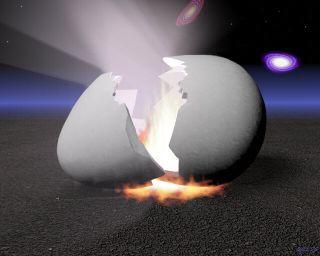1.My initial and pervading question throughout this work concerns the selection of artists Bourriaud chose to represent the 'important' artists of today. The author's interest in investigating a new form of art possible only in today's world of surplus imagery is clear, but in his investigation of this unfolding art form and its possibilities, the vast majority of artists still creating old fashioned art out of more 'raw' art materials (clay, paint, paper, etc.) seem to be irrelevant. I wonder if Bourriaud overlooks humanity's basic and recurrent need, throughout all cultures and histories, to have an object/symbol describing the internal experiences of being a person, and the fact that a piece of art can still function in that way quite well, even using traditional materials, alongside Postproduction art that is reflecting a broader, more collective experience.
2."When artists find material in objects that are already in circulation on the cultural market, the work of art takes on a script-like value: 'when screenplays become form,' in a sense. "
In an attempt to understand Bourriaud's metaphor of 'screenplay' as art, I explain to myself what a screenplay is and does, and what it means when it is the thing presented itself, and not the movie it is written to create. A screenplay, or a script, is the thing not meant to be seen. It has the hidden information a filmmaker, actor, director, camera person and crew, set designer, everyone, needs to create an illusion. In itself it demystifies that illusion. Reading a screenplay puts you on equal footing with the creators of the illusion and is an entirely different experience than being presented with the final film to view. I wonder if being an artist puts one unavoidably in the role of presenter, even if what one is presenting is a 'screenplay.' It seems the role of presenter, influencer, censor and manipulator is unavoidable regardless of what one is presenting. I appreciate the attempt to engage an audience on a more equal level, however it seems some inequality is built in to the role of artist. In the end, there are people choosing to 'make' art, and people who come to see or experience it.
3.In response to Bourriaud's investigation of the equality of consumption and production, or perhaps the simultaneity of those processes, I am struck by the value of that investigation, as an artist and as a citizen of today's world. It is an interesting perspective to pose at all levels of consumption; What am I producing by consuming this product? For example, when I go to the store to buy jeans, I identify myself easily with the role of consumer. I get new jeans. In terms of the responsibility for my role in the consumption/production continuum, there is great value in considering what I am producing by this consumption. Where are the jeans being made? Who is making them, and how am I affecting their life? The community? There has been great damage done, for instance, in Tehuacán, Mexico where jeans are produced, on the water supply. It seems toxic dyes and bleaches are left to run off into the surrounding grounds, explained more in this environmental link.
Considering more deeply what is being produced by this consumption has great effect on future choices and allows us to live more consciously.
4.In response to Bourriaud's statement " Just as through psychoanalysis our unconscious tries, as best it can, to escape the presumed fatality of the familial narrative, art brings collective scenarios to consciousness and offers us other pathways through reality, with the help of forms themselves, which make these imposed narratives material." I am reminded of the art of Harrell Fletcher , The Problem of Possible Redemption, 2004 Whitney Biennial. In this piece Fletcher has seniors from a senior center in Conneticut reading lines from James Joyce's Ulysses. The use of an existing narrative retold by a lost segment of society makes relevant the universal theme of mortality in a way that is cogent with Bourriauds ideas. The video, entitled The Problem of Possible Redemption, can be found on Fletcher's website.
5. Bourriad quotes Uam Gillick as saying "We are all caught within the scenario play of late capitalism" when describing how we are all affected by the 'narratives' of our time. This called to mind a passage of Virginia Woolf's "Orlando", wherein she describes the effect of the 'spirit of the age' upon those living in it. She writes " Such is the indomitable nature of the spirit of the age, however, that it batters down anyone who tries to make stand against it far more effectually than those who bend its own way (244.)" and "For it is probable that the human spirit has its place in time assigned to it; some are born of this age, some of that (244)." Orlando goes on to experience an age that is 'antipathetic' to her. I wonder if the same can be said of artists whose works are not cogent with the Postproduction aesthetic.
Subscribe to:
Post Comments (Atom)


No comments:
Post a Comment